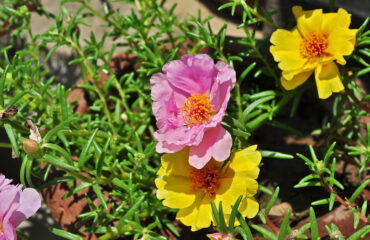Punica granatum, commonly known as Pomegranate, is a deciduous shrub or small tree native to the region extending from Iran to northern India. It is widely cultivated for its edible fruit, which is renowned for its rich, sweet-tart flavor and numerous health benefits. Beyond its culinary uses, the pomegranate is valued for its ornamental appeal, with vibrant flowers and glossy leaves. Propagating Punica granatum can be achieved through various methods including seeds, stem cuttings, air layering, and grafting. Each method offers distinct advantages, making it possible to propagate this versatile and historically significant plant effectively.
Punica granatum (Pomegranate) Propagation Methods
This structured overview covers the diverse propagation methods for Punica granatum, offering practical insights and guidance for both novice and experienced gardeners interested in growing this versatile and fruitful plant.
1. Seed Propagation
Seed propagation is a common method for growing new Pomegranate plants, especially for breeding and genetic diversity.
1.1. Seed Collection
- Fruit Selection: Select ripe pomegranates with fully developed seeds. The best time to harvest seeds is in late autumn when the fruit is mature.
- Seed Extraction: Open the fruit and remove the seeds. Clean the seeds by washing them in water to remove the surrounding pulp.
- Seed Drying: Spread the seeds on a paper towel and allow them to dry for a few days in a well-ventilated area. This helps prevent mold and prepares them for sowing.
1.2. Sowing and Germination
- Sowing Seeds: Sow the dried seeds in pots or seed trays filled with a well-draining seed-starting mix. Place the seeds about 1 cm deep and cover lightly with soil.
- Germination Conditions: Maintain a warm environment (20-25°C or 68-77°F) and keep the soil consistently moist but not waterlogged. Covering the tray with plastic wrap can help retain moisture and warmth.
- Germination Time: Seeds typically germinate within 4-6 weeks, although this can vary. Once seedlings emerge, provide them with bright, indirect light.
- Transplanting: When seedlings have grown a few sets of true leaves and are large enough to handle, transplant them into individual pots.
1.3. Seedling Care
- Hardening Off: Gradually acclimatize the seedlings to outdoor conditions by placing them outside for increasing periods each day.
- Planting Out: After the danger of frost has passed and the seedlings are well-established, they can be planted in their permanent location with full sun and well-draining soil.
2. Stem Cuttings
Stem cuttings are a reliable method for propagating Pomegranates, ensuring that new plants are true to the parent variety.
2.1. Cutting and Preparation
- Selecting Cuttings: Choose healthy, semi-hardwood cuttings from the current season’s growth in late summer or early autumn. Each cutting should be 20-30 cm long and have several nodes.
- Cutting Technique: Use a sharp, sterilized knife or pruners to make a clean cut just below a node. Remove the lower leaves and any flowers or fruit to focus the plant’s energy on rooting.
2.2. Rooting and Planting
- Rooting Medium: Plant the cuttings in pots filled with a mix of sand and peat or perlite to ensure good drainage.
- Rooting Environment: Place the pots in a warm, humid environment with bright, indirect light. Maintain soil moisture by misting regularly or covering the pots with plastic to retain humidity.
- Rooting Time: Cuttings typically take 6-8 weeks to root. Once rooted, gradually acclimatize them to outdoor conditions.
- Transplanting: After roots have formed, transplant the cuttings into larger pots or directly into the garden.
3. Air Layering
Air layering is a propagation technique used for larger Pomegranate plants to produce new plants from existing branches.
3.1. Air Layering Process
- Selecting a Branch: Choose a healthy, vigorous branch that is at least one year old.
- Preparing the Branch: Make a small upward cut or remove a ring of bark around the branch (girdling) to expose the inner wood.
- Applying Rooting Medium: Apply rooting hormone to the exposed area and wrap it with moist sphagnum moss. Cover the moss with plastic to maintain moisture and secure it with ties.
3.2. Root Formation and Separation
- Monitoring: Check the air layer periodically to ensure it stays moist and look for root development. This process can take several months.
- Separation and Planting: Once a substantial root system has developed, cut the branch below the rooted area and plant it in a pot or directly in the ground.
4. Grafting
Grafting is often used to propagate Pomegranates to ensure the desired characteristics of the scion are maintained.
4.1. Grafting Techniques
- Scion and Rootstock: Choose a healthy scion from the desired variety and a compatible rootstock.
- Technique: Common grafting methods for Pomegranates include cleft grafting and whip-and-tongue grafting. Make precise cuts on both the scion and rootstock to ensure good contact and alignment.
- Grafting Procedure: Join the scion and rootstock, secure with grafting tape, and apply grafting wax to protect the graft union.
4.2. Post-Grafting Care
- Environment: Place the grafted plants in a controlled environment with high humidity and indirect light to promote healing and growth.
- Monitoring: Regularly check the graft for signs of compatibility and new growth. Remove any shoots that develop from the rootstock below the graft.
Conclusion
Propagating Punica granatum through seeds, stem cuttings, air layering, and grafting provides a range of methods to suit different needs, from creating genetic diversity to cloning specific cultivars. Each method has its own benefits and challenges, making it important to choose the right technique based on the desired outcome and available resources. By mastering these propagation techniques, gardeners can enjoy the beauty, fruit, and ornamental appeal of Pomegranates in a variety of settings, from home gardens to commercial orchards.




